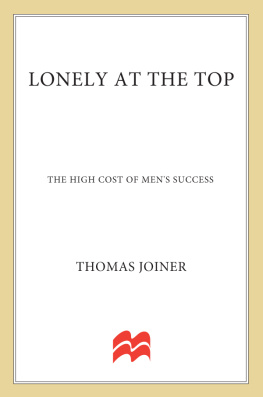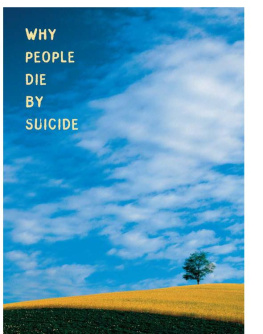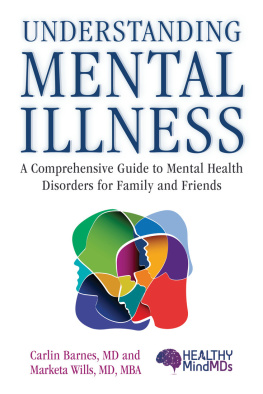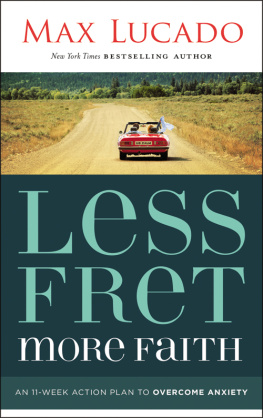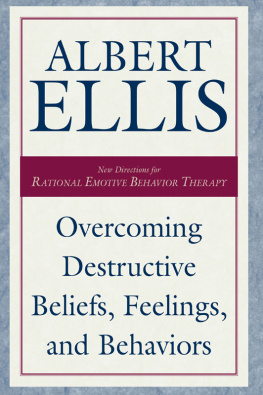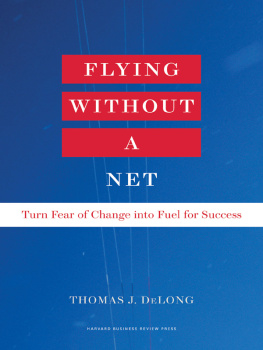LONELY AT THE TOP
THE HIGH COST OF MENS SUCCESS
THOMAS JOINER

The author and publisher have provided this e-book to you for your personal use only. You may not make this e-book publicly available in any way. Copyright infringement is against the law. If you believe the copy of this e-book you are reading infringes on the authors copyright, please notify the publisher at: us.macmillanusa.com/piracy.
LONELY AT THE TOP
Copyright Thomas Joiner, 2011
All rights reserved.
For information, address St. Martins Press, 175 Fifth Avenue, New York, N.Y. 10010.
First published in 2011 by PALGRAVE MACMILLAN in the United Statesa division of St. Martins Press LLC, 175 Fifth Avenue, New York, NY 10010.
ISBN: 978-0-230-10443-3
Our eBooks may be purchased in bulk for promotional, educational, or business use. Please contact the Macmillan Corporate and Premium Sales Department at 1-800-221-7945, ext. 5442, or by e-mail at .
Library of Congress Cataloging-in-Publication Data
Joiner, Thomas E.
Lonely at the top : the high cost of mens success / Thomas Joiner.
p. cm.
Includes bibliographical references and index.
ISBN 978-0-230-10443-3 (hardback)
1. SuccessPsychological aspects. 2. Depression, MentalSocial aspects. 3. MasculinitySocial aspects. I. Title.
BF637.S8J624 2011
155.332dc22
2011009532
A catalogue record of the book is available from the British Library.
Design by Letra Libre
First edition: November 2011
10 9 8 7 6 5 4 3 2 1
Printed in the United States of America.
To the Order of Saint Walpurga
ACKNOWLEDGMENTS
I am tempted to note the good luck that I have a lot of friendsfrom my Atlanta childhood, to Walpurgians, to FSU Psychology, and beyondbut, as I assert in this book, it is not luck. On the contrary, it is active workwork that I relish, am grateful for, and find vitally sustaining.
Speaking of work and gratitude, FSU Psychology is a juggernaut with which I am very proud to be associated. Should you find the claim of juggernaut dubious, check the data, by which I do not mean the ditzy reputational rankings of various magazines, but rather, the numbers on grants, citations, and publications assembled by the National Research Council. A major reason for this success is our remarkable group of PhD students, past and present, among whom mine are, as of this writing, Timmons, Anestis, Bender, Selby, Fink, Smith, Ribeiro, Bodell, Hames, and Silva, and this is not to mention the many PhD alumni of my group, nor (I hope) dozens of future students.
We have assembled an impressive group of professors at FSU Psychology, the breadth and depth of whose work serve as a daily inspiration to me. The ideas in this book benefited in particular from the work and thought of Roy Baumeister, who at work is just across the hall, and who at home is just down the street.
My wife, Graciela, and my sons, Malachi and Zekey, not only appear in these pages, but they give me continued reasons to strive even as they keep me connected.
I am grateful to Jen Hames for diligent editorial assistance. Agent Anna Ghoshs insight and ideas substantially improved this book, as did editor Luba Ostashevskys thoughtful guidance.
SECTION I
THE PROBLEM
1
THE LONELY SEX
HAVING NO ONE STARTS OUT AS HAVING EVERYTHING
As the October sun rose in the Oakland-Berkeley Hills in 1991, the firemen were vigilant, as ever, but they felt confident that they had the previous days blaze under good control. Nevertheless, they understood well that seemingly dormant fires can roar back to life, particularly under conditions of high winds, high temperatures, and active hotspots. As the firemen tended hotspots and sweated into their gear in temperatures in the nineties, the wind swirled. A single glowing ember took flight on the wind and drifted innocently enough outside the original fire zone. The ember floated along and landed in a tree.
Within seconds, the scene turned chaotic and lethal. The tree exploded into flames that spread rapidly; the resulting fire was out of control, and the firemens task changed from fighting the original fires dwindling hotspots to fighting for their own survival. Twenty-five people would lose their lives in the fire, including a firefighter and a police officer.
Others, too, experienced the dramatic shift from everyday activities to a life-or-death battle. The fires scope included homes within minutes; at its most ferocious, it was igniting one home every eleven seconds, forcing homeowners to flee for their lives. In the desperate few moments on their way out of their homeshomes they were unlikely to see again, homes that, in many cases, contained extremely valuable things like artwork, rare books, gold, and jewelry, not to mention stores of cash, and, in at least one case, the sole copy of an authors book in progressthese people were faced with choices. One choice can hardly even be called that: of course people savedor at least attempted to saveloved ones and pets. But beyond each other and pets, what to salvage on the way out the door?
Few if any grabbed art or jewelry, but many people salvaged photographs, pictures of people they loved.
Were the story to end there, some would view it as sweet, others as trite; either way, a basic if incomplete truth is revealed: we need each other. We primates are gregarious, and embedded within our cells and souls is a pressing need to belong and connect. This happened in the hills above Oakland as people reached past jewelry and money to desperately latch onto photos of friends and family. Ending the story there would also produce a homily: gather others around you and you will flourish.
It is not quite so simple. If it were, there would not be millions and millions of lonely people; there would not be a million people worldwide who die every year by suicide; and there would be no need for this book.
Much of human nature can be understood in the context of the truth that we need each other. Much but not all. In the weeks and months following the fire in the hills above Oakland, the same people who had reflexively spurned material things in favor of mere images of those they loved turned on each other and no longer spurned material things.
In his 2000 book, Almost Home, David Kirp quotes one of the people whose home was destroyed: Just when the fire experience is encouraging you to detach from worldly possessions, purify your intentions, and all that, the realpolitik of your insurance policy rises up to A major part of the homeowners advice did not involve Zen: Fight for your price.
In the fires aftermath, very close-knit neighborhood groups developed to support and advocate for one another. But, as David Kirp stated, Once in receipt of their insurance settlements, most residents stopped participating in the neighborhood associations. Some householders who had been leaders in their insurance groups cut their own backroom deals, agreeing not to reveal the terms of their settlement to anyone else in their own group.
The book quoted another resident whose home was destroyed and then rebuilt. Referring to his new home, the resident said, It was God who gave us a magnificent 360-degree view. The logic implicit in this statement is that God decreed that the fire should occur, destroy many homes, injure dozens of people, and take the lives of twenty-five. The statement also omits the fact that the rebuilt house has window views engineered to angle upward, thus avoiding the view of the fires aftermath and also of others homesa kind of purposeful isolation through architecture.

